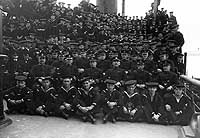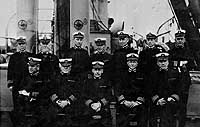UNITED STATES NAVY
TEMPORARY AUXILIARY SHIPS
WORLD WAR I
TEMPORARY AUXILIARY SHIPS
WORLD WAR I

Online Library of Selected Images:
-- U.S. NAVY SHIPS --
USS Canandaigua (ID # 1694), 1918-1919
USS Canandaigua, a 7620-ton (displacement) minelayer, was built at Newport News, Virginia, in 1901 as the 4616 gross ton commercial passenger-cargo ship El Siglo. Transferred from the U.S. Shipping Board to the Navy in November 1917, she was converted to a minelayer at Brooklyn, New York, and placed in commission early in March 1918. In May Canandaigua steamed across the Atlantic to Scotland, from which she operated for the next five months helping to establish the North Sea mine barrage. Following the November 1918 Armistice, the ship returned to the U.S., where she was converted to a troop transport. Between March and August 1919 Canandaigua was employed bringing service personnel home from France. She was decommissioned in September 1919 and turned back to her owners by way of the Shipping Board. In about 1922, while again named El Siglo, the Navy assigned her the new identification number 4510 as a possible mobilization asset in case of a National emergency, but she had no additional Naval service.
This page features all available views concerning USS Canandaigua (ID # 1694).
Click on the small photograph to prompt a larger view of the same image.
|
Photo #: NH 99625 USS Canandaigua (ID # 1694) Halftone reproduction of a photograph showing the ship tied to a mooring buoy, circa 1918, probably in a British Isles harbor. Note her pattern camouflage. Collection of Clarence E. Grisso, donated by R.W.G. Vail, 1934. U.S. Naval History and Heritage Command Photograph. Online Image: 48KB; 740 x 345 pixels |
 |
|
Photo #: NH 55558 USS Canandaigua (ID # 1694) Ship's officers and crew posed on deck, at Invergordon, Scotland, October 1918. Her Commanding Officer, Commander William H. Reynolds, is seated in the middle of the second row. U.S. Naval History and Heritage Command Photograph. Online Image: 96KB; 740 x 535 pixels |
 |
|
Photo #: NH 53575 USS Canandaigua (ID# 1694); USS Roanoke (ID # 1695); USS Canonicus (ID # 1696); and USS Housatonic (ID # 1697) Sketch of "Rearrangement of Steering Gear" on ships' bridges, made at the Norfolk Navy Yard, Virginia, 23 April 1918. U.S. Naval History and Heritage Command Photograph. Online Image: 81KB; 590 x 765 pixels |
 |
|
Photo #: NH 52819 Mine Squadron One, U.S. Atlantic Fleet Senior officers of the squadron, photographed on board ship in the North Sea area, September 1918. Those present are identified in Photo # NH 52819 (complete caption). U.S. Naval History and Heritage Command Photograph. Online Image: 96KB; 740 x 430 pixels |
 |
|
Photo #: NH 52995 Mine Squadron One, U.S. Atlantic Fleet Senior officers of the squadron, photographed on board ship in the North Sea area, September 1918. Those present are identified in Photo # NH 52995 (complete caption). U.S. Naval History and Heritage Command Photograph. Online Image: 88KB; 740 x 495 pixels |
 |
USS Canandaigua is seen distantly in the following Photographs:
The ships seen in the following photograph MAY include USS Canonicus:
NOTES:
Page made 18 October 2004
New image added 18 October 2010




